NVIDIA GeForce Experience Update: 4K GameStream & 1080p Twitch; Driver Update Changes To Come
by Ryan Smith on October 15, 2015 9:00 AM EST- Posted in
- GPUs
- GeForce
- NVIDIA
- GeForce Experience
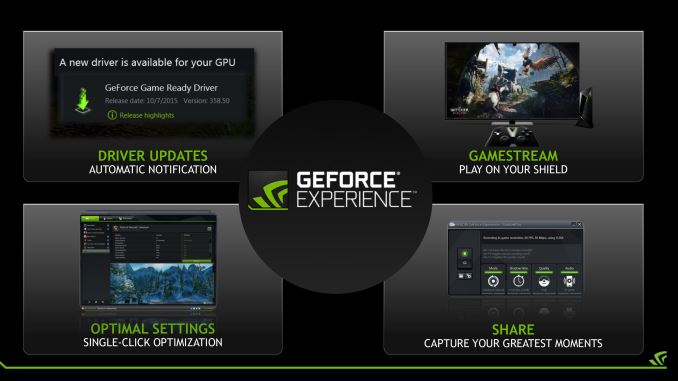
Since launching their GeForce Experience software utility over two years ago, NVIDIA has continued to iterate on it in a fairly regular fashion. Along with its software update and game settings optimization features, NVIDIA has added a number of features over the past couple of years tied to their NVENC hardware encoder, including GameStream, ShadowPlay, and most recently the beta for Share and GameStream Co-Op. As one might expect, NVIDIA is not stopping there, and in a briefing to the press this week, NVIDIA is announcing some of their feature development plans for GeForce Experience over the next couple of months.
To kick things off, in a new beta release hitting NVIDIA’s servers today, NVIDIA will be updating several of GeForce Experience’s various NVENC-powered features to enable new features. On the GameStream front NVIDIA will be offering new functionality specifically targeted at the recently launched SHIELD Android TV set top box. With the SHIELD Android TV capable of decoding 4K video content, NVIDA is now giving GameStream the ability to encode video at that resolution, allowing for GameStream remote gaming at full native resolution for 4K TVs. Furthermore NVIDIA is also giving GameStream the ability to serve up 5.1 audio.
Until this latest release GeForce Experience had been limited to serving up GameStream with 1080p video and stereo audio, so this marks a significant increase in GameStream’s video and audio quality. At the same time because of the step up in quality the system requirements to use the new 4K mode are significantly higher as well. On the encode side only the newest Maxwell 2 generation GPUs have an NVENC unit capable of encoding at 4Kp60, so high-end Kepler users won’t see this functionality. Meanwhile on the reception side, a SHIELD Android TV is needed to receive 4K video, and NVIDIA is recommending a hardwired 100Mbps (or better) Ethernet connection for best performance. And on a technical side note, though not specified in NVIDIA’s presentation, as 4K support is limited to SHIELD Android TV I’m curious whether NVIDIA is still using H.264 or if they’re switched to HEVC, as Maxwell 2 and SHIELD Android TV support hardware HEVC encoding and decoding respectively.
Moving on, similar to GameStream, GeForce Experience’s video broadcasting module is also getting new functionality and an image quality boost. First launched with Twitch support back in late 2013, the broadcast module is now gaining support for Google’s rival YouTube Live service as well, allowing GeForce users to broadcast to the service of their choice. Furthermore the broadcast module can now upload video streams at 1080p60 with a maximum bitrate of 9Mbps, supplanting the module’s previous 720p60 limit. As even older versions of NVENC have long been able to record at 1080p, this change primarily appears to be NVIDIA increasing their limits now that these services are better able to handle the high bitrates that go with 1080p streaming.
The Next Few Months: Driver Updates Shift to GeForce Experience
Finally, in their last announcement for the day, NVIDIA is sharing a bit of information on their plans for GeForce experience for the rest of the year, and this is a big one.
Starting with a December update to GeForce Experience, NVIDIA will be overhauling how they distribute their driver updates. The company currently posts new drivers on a regular basis to their website while also simultaneously pushing them out via GeForce Experience. Come December, that will be changing and GeForce Experience will be the preferred “first access” distribution mechanism for NVIDIA’s frequent driver updates.
This change comes on the heels of NVIDIA’s latest research, which finds that 90% of all driver updates are now distributed through GeForce Experience. At this point NVIDIA is not discussing the change in great detail – and most likely they’re still sorting out the finer details of what they want to do – but the basic idea is to fully exploit the push update mechanism of GeForce Experience while drawing users into what will in time become a larger NVIDIA ecosystem. GeForce Experience will be used to distribute the company’s regular “point release” driver updates that the company frequently releases and typically contain bug fixes and performance improvements for gamers – in other words the drivers most gamers will want to be on. Meanwhile NVIDIA will still post drivers to their website (and by extension Windows Update), but on a reduced quarterly cadence.
One thing NVIDIA has made clear is that they’re sticking with their overall Game Ready driver release system – targeting frequent driver updates to line up with major game launches – and this includes WHQL certification, so this won’t be NVIDIA cutting back on WHQL releases despite the fewer updates to their website. However even with WHQL certification, NVIDIA’s frequent driver releases (20 in just over the last year, not counting hotfixes) have been both a curse and a blessing for their wider user base, as non-gamers use the same drivers. I get the impression that this change is in part driven by a desire to establish separate “gamer” and “long term” driver release cadences where non-gamers aren’t constantly being bombarded by Game Ready point updates that primarily affect software they aren’t using.
At the same time however NVIDIA is also being straightforward about this driver change being part of a broader effort to promote GeForce Experience from a utility to a critical part of the GeForce ecosystem and to make it a software backend of sorts to their GPUs. The change in driver distribution will be accompanied by a yet to be fully detailed registration system where NVIDIA will be asking users to register their email addresses with GeForce Experience. NVIDIA has already been toying with this concept this year by using GeForce Experience to distribute game codes, so while it’s not fully clear what NVIDIA intends to do with a registered user base this is clearly the latest step as part of building their ecosystem.
More broadly speaking, NVIDIA has been pushing the larger GeForce ecosystem concept for even longer than GeForce Experience has been around – through G-Sync, PhysX, 3D Vision, and other technologies – and the company has made it clear for years that they see their continued success as coming from not just offering gamers solid hardware, but offering a wholly integrated experience. Given that PC gaming is otherwise one of the few bright spots in a tough market for PCs – year-over-year worldwide sales were down 7.7% for Q3 – it makes a great deal of sense for NVIDIA to want to further bolster their hand in the PC gaming market.
I am however curious to hear more details in the coming months about how the registration mechanism and revised driver distribution system works in GeForce Experience, what else NVIDIA will be doing with their growing ecosystem, and what GeForce owners think of this. Web based driver updates are older than the formal concept of the GPU, so NVIDIA’s plans mark a significant change in how drivers are at least preferably distributed. Though to NVIDIA’s credit they have clearly thought this through – even downgrading has been considered and NVIDIA will be building in a downgrade mechanism into the GeForce Experience driver update module. And ultimately with NVIDIA’s 90% distribution figure, it would appear that web downloads were already a quickly dying trend anyhow.
Wrapping things up, NVIDIA tells us these latest and upcoming improvements to GeForce Experience will be followed by further improvements for GeForce Experience in 2016. NVIDIA has stated that they have an “interesting roadmap” for the utility for the next year, one that will no doubt further flesh out this software ecosystem that the company is quickly assembling.


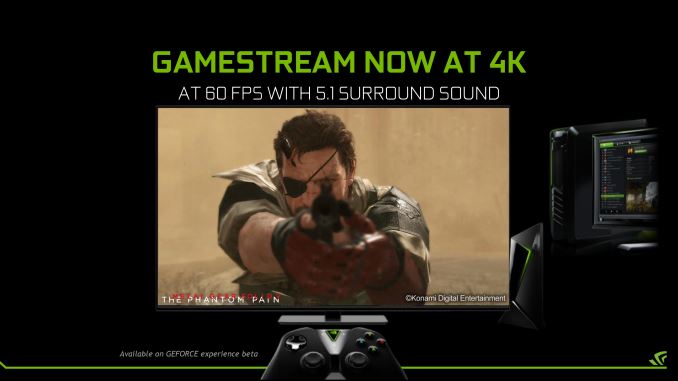
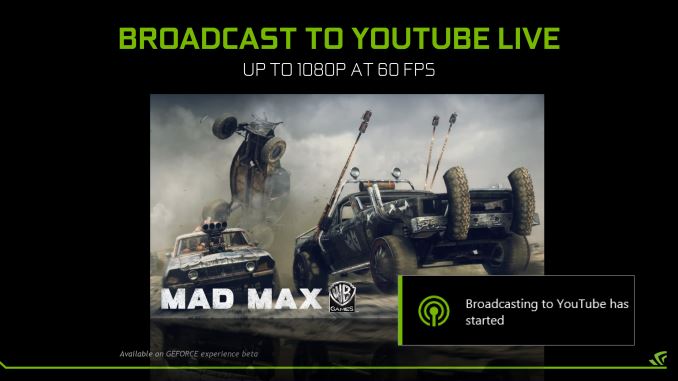
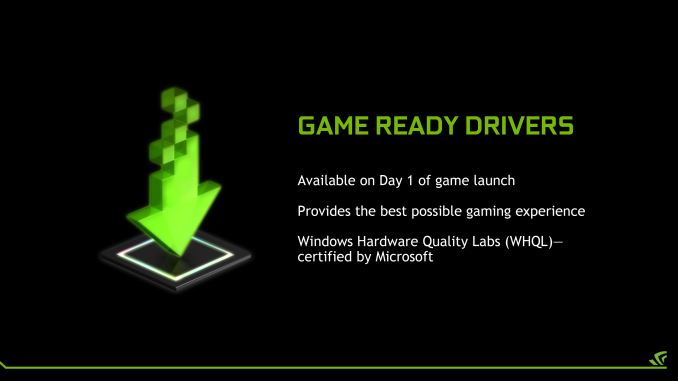
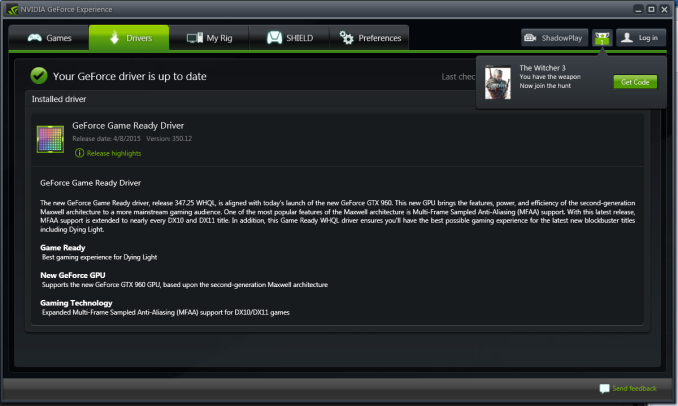








54 Comments
View All Comments
Zak - Thursday, October 15, 2015 - link
It doesn't give me anything I find useful, I don't need to have software installed on my PC that doesn't do anything for me. I don't record or stream games, I tweak them myself and I like to download and install drivers myself. I tried GE few times and it misconfigured my games terribly and always got stuck installing driver update. I don't want to learn anything or adapt to anything that doesn't give clear benefit.yllanos27 - Thursday, October 15, 2015 - link
Nothing wrong on my side either.Have you tried a recent version?
ZeDestructor - Thursday, October 15, 2015 - link
[citation needed]On my machine: no measurable extra CPU usage (except when it bugs out), some increased RAM usage (about 200MiB.. on a machine with 32GiB of RAM) and no internet usage until it downloads updates or stream (verified using my router).
greyhulk - Thursday, October 15, 2015 - link
This program pretty consistently runs away with CPU clock cycles every time it's installed. When the fix that, call me.Morawka - Saturday, October 17, 2015 - link
High Profile AAA Games rarely use over 30% CPU Cycles as it is... Witcher 3, for example, uses 35% on my 4790K @ 1440p.. That's a high resolution.The actual video decoding is built into the GPU DIE itself, so no wasted resources there, its a hardware encoder. Smartphone cpu/gpu's use these dedicated hardware blocks religiously. so do consoles.
GFE is a great tool that lets you "just start playing games". If you think about it, How GFE works, you really have to marvell at what nvidia has done here. They simitaniously test a game on all resolutions, on all CPU hardware (i3, i7, amd, etc.) and on all graphics cards, (GTX 480, 580, 660, etc..) in a matter of hours, and find the optimal image quality, and performance profiles.
It doesn't matter if you use it or not, what nvidia has done here is showing the power of GRID and Cloud computing and is a pillar of software complexity.
Nvidia is trying to make PC gaming as simple as console gaming, to lure more gamers to the master race. Rather you like AMD or Nvidia, this is good for PC Gaming.
LinkTiger - Thursday, October 15, 2015 - link
Now if only they'd allow driver updates to be triggered by Standard users (with a UAC prompt, of course; this is kernel-level code they're updating). Right now, on Windows 7, graphics driver updates are the only thing that I can't do from my Standard User account, even with UAC and right-click "Run as Administrator".Zak - Thursday, October 15, 2015 - link
This is just stupid. I don't care for GeForce Experience. The few times I used it it misconfigured my games badly and it was never able to complete a drive update.yllanos27 - Thursday, October 15, 2015 - link
What is interesting to me is that there is no comment about what are they doing in the Steam Machines front.DAOWAce - Thursday, October 15, 2015 - link
Meanwhile, just having GFE installed breaks NVIDIA Inspector's profile exporting.I have dozens of profiles customized and saved, which I need to reload after a driver installation because it resets a bunch of the settings in them. And then with GFE installed, it resets a ton more, not to mention silently changing things behind the scenes. This means in order to export my profiles so I can load them after a driver update, I have to uninstall GFE. After finding this out, I opted to uninstall it entirely (of which it was only installed for a week after all these years to see the behind-the-scenes profile updates it had).
This is completely asinine. No driver should ever be available solely through a horridly bloated program that requires internet connectivity.
mobutu - Thursday, October 15, 2015 - link
So let's see, right now, a simple nvidia geforce driver contains the following (thank god for now I can choose the components I want):-graphics driver
-hd audio driver
-physyx
-3dvision
-3dstero something like that.
etc
Obviously I install only the graphics driver because I have no need for the other components.
Now (in the future), nvidia wants my email address so i can get my graphics driver (THE only thing I want!) and in addition to all of the above they'll give me more crap like streaming (lol), gfexperience, shadowplay, co-op, sharing, broadcast etc , all useless for me.
And on top of all these, the corresponding (windows) services and start-up apps for this crap will hog my system.
I'm ok as long this shovelware will be optional.
But ofcourse, the masses being dumb, this will end down in our throats mandatory for all sometime in the future.
Sad.